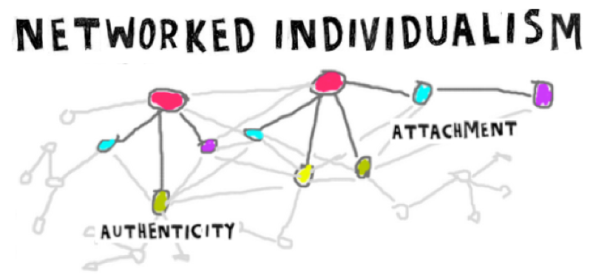rod beckstrom – decentralization

book links to amazon
co-authored with Ori Brafman
_________________

__________________
Find Rod on wikipedia, https://twitter.com/RodBeckstrom
his site:
we found him via Jason – who suggested we read – The Starfish and the Spider:
Major principles of decentralization:
1. when attacked, a decentralized organization tends to become even more open and decentralized.
2. it’s easy to mistake starfish for spiders
3. an open system doesn’t have central intelligence; the intelligence is spread throughout the system.
4. open systems can easily mutate
5. the decentralized organization sneaks up on you
6. as industries become decentralized, overall profits decrease
7. put people into an open system and they’ll automatically want to contribute
some other things that denote decentralization: no person in charge, no real hq’s, no division of roles, if a part wiped on – carries on, knowledge/power distributed, flexible, can’t count participants, participants communicate directly
because no one is in charge – everyone is responsible
the real culprit is the system.
it’s not that open systems necessarily make better decisions. it’s just that they’re able to respond more quickly because each member has access to knowledge and the ability to make direct use of it. – p. 39
open system – no way to tell how many members, no one knows, because no one is keeping tabs. constantly mutating, flexible, equal.
there isn’t an ownership issue, more of a delight in remix issue…
as soon as an outside force presents itself, the decentralized organization quickly mutates to meet the new challenge or need
catalyze a new idea, then get out of the way. leaving the organization without a central brain, and, in so doing, giving it the power to mutate and continually alter its form
the starfish can take over an entire industry in the blink of an eye
at the extreme of decentralization, we encounter a gray zone wehre a very loose collection of people have a surprising amount of power.
talking of #7 above and burning man: It’s strange how quickly you get used to this gift economy. It’s liberating to feel that nobody is trying to sell you anything. If you want their product, you can have it. If you don’t, that’s fine.
when you give people freedom, you get chaos, but you also get incredible creativity.
wikipedia proves that people are basically good.
5 parts: 1\circle (independent, autonomous, , 2\catalyst (a person who initiates a circle and then fades away – visionary), 3\ideology (motivating factor to stay decentralized – more meaningful the ideology – longer lasts), 4\pre-existing network, 5\champion (implementor – catalysts inspire & naturally connect, champion is not subtle – rather – relentless)
on wikipedia – et al – nobody is the boss of anybody. people just pick up projects and work on them. no schedule, no direction.
catalyst:
- people really, really want to help other people, and that’s the most underutilized tool there is.
- to a catalyst – people are like walking novels
- it’s at that point, when we feel understood, that we are most open to something new. we become willing to change
- thrive on meeting new people everyday
- people wouldn’t return Auren’s phone calls if they thought he was just trying to get something from them.
- provides the drumbeat for a decentralized organization
- doesn’t try to persuade people, but rather, meets people where they are
- you don’t follow a catalyst because you have to, you follow a catalyst because he understands you
- when we give advice to someone, we automatically create a power hierarchy (detrimental)
- if she had talked nuts & bolts, it would have been much harder to form an emotional bond
- work toward a goal that often doesn’t involve personal gain
- with a flattened hierarchy – you never know what people are going to do. you can’t control the outcomes, and you can’t really reproach a member if he becomes errant.
- don’t you dare make me out to be the hero – this isn’t about me
- one of the most common answers from catalysts – i don’t know – not because they are absent minded, but because there aren’t concrete answers to those questions, being a catalyst requires a high tolerance for ambiguity (that’s because a decentralized organization is so fluid that someone who needs order and structure would quickly go mad.)
- ambiguity creates a platform for creativity and innovation. if someone came in and tried to implement order and structure, they might be able to get better measurements and tracking, but they’d ill the starfish in the process.
- most difficult and counterintuitive element of being a catalyst – getting out of the way
- in a command and control environment, you can closely track what everyone is doing, but being watched an monitored makes employees less likely to take risks and innovate
- at the same time – when left to own devices, members of a starfish organization can become frustrated with the catalyst. “What are we supposed to be doing they may ask. But it’s precisely this question that leads people to take charge, giving members a high level of ownership oer the organization.
The moment you introduce property rights into te equation, everything changes: the starfish organization turns into a spider. – driven by competition..
at ebay – they are required to begin with the assumption that people are basically good and trustworthy
the open source movement has thrown the industry into chaos. the availability of free open-source alternatives means that customers have a lot more freedom to leave. – if you love someone, set them free. – as industries decentralize, will companies give their customers freedoms that were previously unimaginable?
where creativity is valable, learning to accept chaos is a must
Rod Beckstrom – The Starfish and the Spider
cut the head of a spider off – it dies, because it’s a centralized organism
cut off the arms of a starfish – it comes back, in the amazing Linckia – cut off all five arms, five new starfish
why – because it’s perfectly decentralized. it does not have a single central organ.
the most important trend – swing back – from top down – to flat.
________________________
_________________________




















